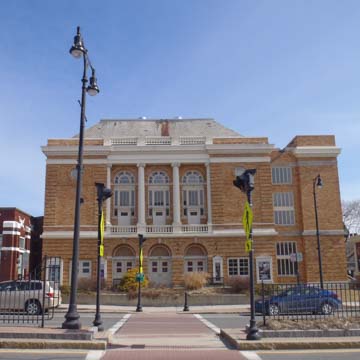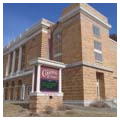Pittsfield’s Colonial Theater opened in 1903 and quickly became a fixture of the city’s downtown. The theater’s shifting uses over the twentieth century chart the evolution of entertainment in the city and the United States in general, while also reflecting aspects of the development of Pittsfield, the seat of Berkshire County and a former industrial center in western Massachusetts. The theater underwent a substantial restoration in the late twentieth century and has become an emblem of the city’s revival following its postindustrial decline.
Once an agricultural community, Pittsfield became a major woolen manufacturing center by the late nineteenth century. Additionally, the physicist and inventor William Stanley moved his Stanley Electric Manufacturing Company, an early producer of electric components, to Pittsfield in 1891, the year Pittsfield incorporated as a city. General Electric purchased the company in 1903 and had a substantial presence in the city throughout the twentieth century.
As the city grew, so too did its population’s desire for recreation and entertainment facilities. The Pittsfield Academy of Music formed in 1872 to host touring theatrical productions. The Academy’s performance space occupied the second story of a downtown commercial building and was accessible only by two narrow, winding staircases, which created a serious fire hazard for the performers and audience. Concerned city authorities revoked the Academy’s license to operate in 1902, leaving Pittsfield bereft of a theater. This move especially galled residents because North Adams, a rival industrial city to the north, boasted two sumptuous, 1,200-seat theaters by 1901.
Local businessmen and civic leaders sought to muster the funds for a theater, but, in an ironic twist, a consortium of eight siblings from North Adams, the Sullivan Brothers, bought land in the center of Pittsfield in 1902 as the site of the future Colonial Theater. The parcel on South Street was located just a few blocks from Park Square, the historic town common around which were sited Pittsfield’s civic, cultural, and religious institutions. Thus, the Sullivan Brothers hoped to establish a theater that would become an integral and respectable part of Pittsfield’s cultural life.
Despite being created by outsiders, the new Colonial Theater opened to fanfare in 1903. Its dignified exterior and opulent interior bespoke Pittsfield’s wealth and sense of regional preeminence, but also reflected the design concepts of Gilded Age theaters throughout the nation. The frugal Sullivan Brothers saved money on the theater’s construction by hiring a local architect, Joseph McArthur Vance, to execute plans that the brothers had earlier commissioned from McElfatrick and Son, a nationally prominent theater design firm. The resulting edifice’s Classical Revival front facade boasts three arched entryways on the ground floor and a recessed bay above with three arched windows spanning the second and third stories. The recess allows for a porch defined by a balustrade and four double-height Ionic columns and half columns. Flanking bays each have a single oriel window lighting the third story. A belt course demarcates the ground floor from those above, and the building has a heavy cornice topped by a low parapet wall, all of which is punctuated by a balustrade over the central recessed bay. These ornamental details are white, which stands out against the light brown and tan brick walls.
Within, the large auditorium space flaunts a showy combination of Classical Revival and Beaux-Arts elements to create a majestic, impressive, and lavish interior space. Fanciful plaster molding surrounds the proscenium arch, loges, and edges of the theater’s two galleries. Elaborate Corinthian columns support the balconies and loges. Above the proscenium arch, a mural depicts personifications of Art and Music. In addition to its visual extravagance, the Colonial Theater contains excellent natural acoustics, reflecting its construction in an era before electronic amplification.
The Sullivan Brothers had connections to Charles Frohman, one of six men who led the New York City–based Theatrical Syndicate, an agency that exerted monopolistic control over the nation’s top touring theatrical productions and actors during the first decade of the twentieth century. This relationship meant that the Colonial Theater initially hosted some of the most popular performances of the time. Yet by 1910, the Theatrical Syndicate had stopped sending top-rated shows to Pittsfield, leading to a decline in the Colonial’s revenue since patrons, used to high-quality performances, frequented the theater less.
In 1912, a partnership of Pittsfield’s civic leaders bought out the Sullivan Brothers’ control of the theater. This group of local investors disassociated the Colonial from the Theatrical Syndicate at a time when many other New England theaters, also upset with the Syndicate’s autocratic booking polices, severed ties with the agency. The newly formed Pittsfield Theater Company hired a production manager who led a troupe of actors in stock productions and some touring theatrical performances still came through the Colonial.
The Pittsfield Theater Company failed to make their citizen-controlled theater operation profitable and sold the building to Samuel and Nathan Goldstein in 1914. These brothers from Springfield had owned penny arcades and nickelodeons for nearly a decade in that city, but sought to expand and acquire a portfolio of small theaters in western Massachusetts. The Goldstein Brothers diversified the entertainment offerings at the Colonial, introducing film and vaudeville. Stock theatrical productions and musical performance also continued to fill the theater. After the Great Depression, though, the theater’s profits declined sharply. As Pittsfield’s inhabitants struggled, entertainment became a luxury. The Goldstein Brothers adapted and, in 1937, renovated the Colonial’s front facade, adding a marquee and space for two ground-floor retail shops. More significantly, the brothers installed modern motion-picture projection equipment, and the Colonial became exclusively a movie house showing second-run films. Vance, the original architect, completed these exterior alterations.
The Goldstein Brothers fought to keep the theater running through the Depression and World War II, yet by the early 1950s, their enterprise could not compete with new entertainment technologies such as drive-in movies theaters and, importantly, television. Despite the earnest efforts of its proprietors, the Colonial could not seem to make a profit in the face of home entertainment. It closed in 1952. Fortunately, Samuel Goldstein was fond of the aging theater and decided to sell the Colonial to the lowest bidders, George and Sally Miller, who promised to not demolish the venerable building as the other bidders had intended. Instead, the Millers converted the ground floor of the theater into an art supply shop by installing a dropped ceiling that led from the mezzanine to the stage. This peculiar arrangement kept all the original decoration and structure intact. Both George and Sally Miller hoped to see the Colonial eventually restored, yet as industrial manufacturing waned in Pittsfield, it took decades to muster the funds or necessary public support for the costly project. The Millers stewarded the site for over forty years, and it is thanks to their affinity for the Colonial that is was not torn down like so many of its contemporaries.
George Miller passed away in 1992, but his children inherited the business and kept the hope of restoration alive. In 1996, a group of concerned and interested citizens formed the Friends of the Colonial Theater Restoration to build awareness and advocate for the theater. Municipal, state, federal, and private funds slowly filtered in. A 1998 city-wide referendum questioned Pittsfield residents about various rebuilding projects in the downtown, and the Colonial Theater restoration received overwhelming support. Additionally, in 1998, the federal initiative, Save America’s Treasures, a joint National Park Service and National Trust for Historic Preservation program, designated the Colonial Theater restoration as one of the first sites to receive an endorsement. First Lady Hilary Clinton visited the Colonial, thus giving the project national attention and inspiring further contributions. Eventually, a combination of state and municipal funds, historic rehabilitation tax credits, and private donations funded the $21.6 million renovation.
In 2001, the Colonial Theater Association, a new nonprofit group, purchased the building. Over the course of five years, workers restored the Colonial to its early-twentieth-century grandeur. Moreover, the theater’s renewal involved a substantial addition to its southern elevation. This new three-story addition housed a modernized, fireproof stairwell, and its exterior incorporated identical bricks and continued the main building’s cornice line. The Colonial’s restoration was one part of a larger revitalization of both downtown Pittsfield and the Berkshire region. Many of Pittsfield’s streets, public spaces, and historic storefronts received attention and Berkshire County, long a fashionable vacation retreat, transformed itself into a vibrant cultural and arts hub, capitalizing on the opening of MASS MoCA, a contemporary art museum in a converted North Adams factory complex; Tanglewood, the summer home of the Boston Symphony Orchestra; and other nearby museums and cultural attractions.
The Berkshire Theater Group now owns and operates the Colonial Theater, which, as it did a century ago, hosts theatrical productions, musical performances, comedy acts, and other live shows. In this way, the Colonial Theater provides contemporary audiences a sense of continuity with the past. Yet in a larger context, the Colonial Theater’s restoration demonstrates the dramatic changes that have characterized both the entertainment industry and the city of Pittsfield during the twentieth and twenty-first centuries.
References
Whitman, Nicholas, et al. The Colonial Theater: A Pittsfield Resurrection. Williamstown, MA: Nicholas Whitman, 2008.
Pittsfield Historical Commission and Planning Board. “Form B-Building: Colonial Theater, Pittsfield, MA (PIT.62).” Boston: Massachusetts Historical Commission, October 11, 1978.






